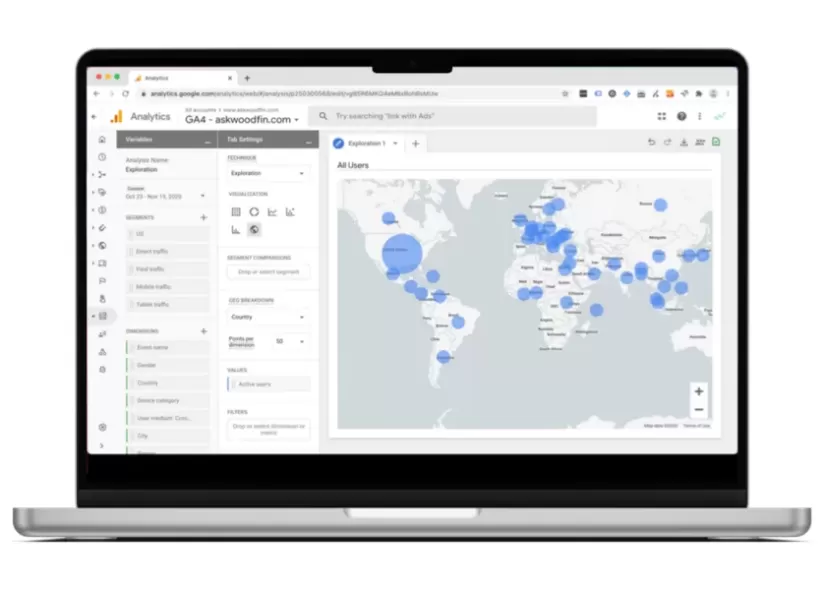Advanced analytics involves the collection, analysis, and use of data to drive strategic decision-making and optimize marketing efforts. It provides significant benefits, including the ability to understand user behavior, gauge marketing performance, and align marketing efforts with overall business goals. The key metrics and insights you should be tracking depend on your unique business goals and KPIs, but they often include user demographics, traffic sources, engagement metrics, and conversion rates.
Analytics best practices for digital marketing
To make the most of analytics, you need to set up custom tracking for specific goals, segment your audience for more detailed analysis, and track conversions through the entire sales funnel. Additionally, tracking multi-channel attribution can provide insights into the customer journey, and using tools like heatmaps and session recordings can give you a deeper understanding of user experience.
Advanced segmentation and audience analysis
Segmentation involves dividing your audience into distinct groups based on shared characteristics, such as demographics, behavior, or source of traffic. By segmenting your audience, you can better understand different user groups, tailor your marketing efforts to each segment, and ultimately increase conversion rates.
Conversion tracking and optimizing the sales funnel
Conversion tracking involves monitoring the actions users take on your site that are valuable to your business. This can provide insights into what's working and what's not in your marketing strategy. Goal funnels, on the other hand, allow you to visualize the steps users take to complete a conversion and identify where they're dropping off. By optimizing these funnels, you can remove barriers to conversion and improve your site's performance.
Tracking multi-channel attribution and customer journey
Multi-channel attribution involves tracking all the different channels and touch points that contribute to a conversion, specifically anywhere you have shared messaging associated with a particular campaign. This can provide a more holistic view of the customer journey and help you understand how different channels work together to drive conversions.
Enhancing UX for better results
Tools like heatmaps and session recording can provide visual insights into how users interact with your site. Heatmaps show where users click, scroll, or move their mouse, while session recordings allow you to watch replays of user interactions. These insights can help you identify usability issues, understand user behavior, and optimize the user experience so it’s easier for visitors to become prospects, leads, and sales.
Remember, the goal of these best practices is to use data to inform your decision-making process, so you can refine your marketing strategy and achieve better results.

Analytics tracking services for medium to large businesses
Several analytics tracking services meet the specific needs of medium to large businesses. These include Google Analytics 4 Ecommerce tracking, custom event tracking, and tag management systems. Mobile app tracking and measurement can also provide valuable insights, especially if your audiences tend to look for your products or services more on those devices.
Among the most significant benefits for medium-to-large businesses is the ability to garner granular customer insights. Given their access to more extensive data, these businesses can delve deeper into customer behavior and preferences. This deeper understanding paves the way for more personalized and impactful marketing strategies tailored to diverse audience segments. Advanced analytics can also provide detailed insights into which marketing channels and campaigns yield the most return on investment. This is especially important when your business has a considerable marketing budget to allocate and optimize.
The scalability offered by digital analytics is another unique advantage for medium-to-large businesses. Analytics allows your business to monitor and assess the success of your strategies across a broad scale, accommodating for extensive customer bases and wider product ranges. As such, the data derived from analytics can drive effective scaling strategies, enabling your business to grow without losing sight of your performance metrics.
The volume of data available to larger businesses can enable advanced testing and predictive analytics. With more substantial traffic and data, you can conduct rigorous A/B testing, resulting in more reliable, statistically significant results to inform marketing decisions. Meanwhile, predictive analytics allows your business to anticipate future trends and changes in customer behavior so you can adjust your strategies proactively. Coupled with the capability to integrate analytics with existing software systems, such as CRM and ERP, your business can achieve a more comprehensive understanding of your performance and devise coherent, effective strategies. It's important to remember, though, that to see the best results, your business should have a solid analytics strategy and a steadfast commitment to data as a source of common knowledge.
Use analytics to make data-driven decisions
Advanced analytics will provide all the information you need to create actionable insights. Through data visualization and reporting, A/B testing, and predictive analytics, you can make data-driven decisions that drive growth. Incorporating machine learning and AI can make your analytics more focused, as well as create efficiencies that also contribute to a better ROI.
You can then start refining your information by enhancing your analytics with external tools and integrations. Third-party tools can provide additional insights, and integrating your CRM and marketing automation platforms can enhance your analytics. Additionally, integrating different channels and tools, like social media and ad platforms, can provide more comprehensive tracking.

Get help setting up accurate, actionable marketing analytics
Analytics should provide more than just tracking website performance. They are a view into user behavior and can offer holistic views of your marketing programs across multiple channels. To capitalize on analytics, they should establish comprehensive tracking using tools like Google Analytics, segment audiences for personalized marketing, set up conversion tracking, analyze multi-channel customer journeys, enhance user experience using heatmaps and session recordings, and regularly audit their analytics data. The insights derived from these actions should be used to guide your marketing decisions to help you boost website traffic and conversions. Plan for an ongoing cycle of tracking, analyzing, and optimizing to get the best results.
Want some help understanding what’s right for your business? We can help you decide what to track, show you how to measure and share results, and assist in building strategies based on your data. Contact us today to get started!
